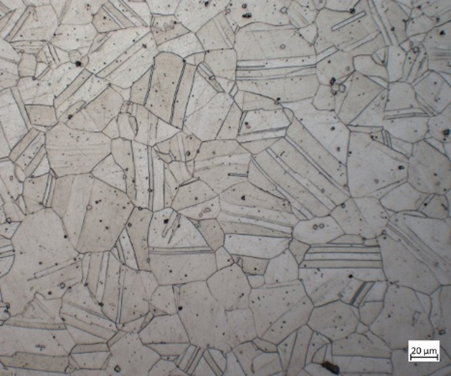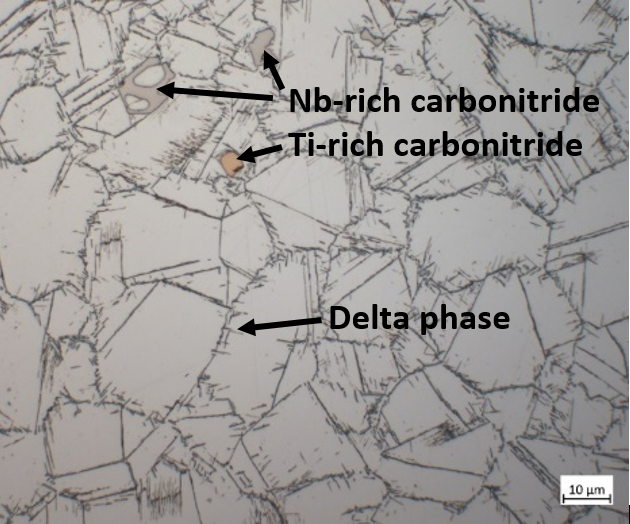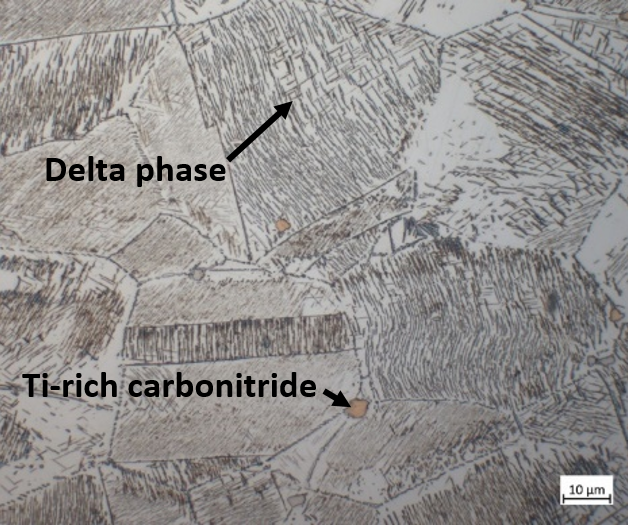Nickel-Base Superalloy 718 Microstructure Characterization
Market Insights
Nickel-base superalloy 718 microstructure characterization
Carpenter Technology’s 718 is a precipitation hardenable (PH) nickel-base superalloy. It is made of a γ matrix strengthened by a combination of Ni3(Ti,Al)-γ’ (gamma prime) and Ni3Nb-γ’’ (gamma double prime) precipitates and also contains carbides and the Nb-rich δ phase. It is a workhorse alloy in the aerospace and oil and gas industries because of its exceptional high-temperature strength and creep resistance, as well as good corrosion resistance. Critical to manufacturing an alloy with such high performance is understanding the processing-properties-microstructure relationship, and materials characterization sits at the center of that understanding.

Figure 1. The processing-properties-microstructure relationship can be envisioned as a pyramid supporting material performance at the apex.
Carpenter Technology’s materials characterization expertise is centered in the R&D Characterization Laboratory. Here, samples of 718 are prepared and polished for either light optical observation (LOM) or scanning electron microscopy (SEM). For LOM, samples are usually etched with Waterless Kallings or Lucas’ Reagent, specialty etchants to reveal the grain size and microstructure. Some features are too fine for optical microscopy and must be observed by SEM. These observations about the alloy’s microstructure reveal critical information about its processing and properties, and the link between them.
Grain structure
A fully recrystallized microstructure with a fine uniform grain is necessary to yield good mechanical properties. When grains are too fine, the alloy strength suffers, and when grains are too coarse, the stress rupture properties suffer. Large un-recrystallized grains (URGs) have a much larger size than the average (Figure 2) and indicate that the solution temperature was too low to achieve full recrystallization. Unrecrystallized grains severally affect stress rupture properties, but their presence in the billet can be identified during sonic inspection.

Figure 2. Unrecrystallized grain (URG) within an otherwise uniform grain structure, etched with Waterless Kallings.
718 phases
Gamma double prime (γ’’)
Unlike most nickel-base superalloys that are γ’ strengthened, 718 is mainly strengthened by γ’’ precipitates in the peak age condition. γ’’ has an ordered DO22 structure and a Ni3Nb composition and appears as nanometer scale discs under the transmission electron microscope (TEM). (Figure 3).

Figure 3. TEM dark field image of gamma double prime.
Gamma prime (γ’)
γ’ plays a minor role in the strengthening of 718. It has a Ni3(Al,Ti) composition, is spherical in shape, and appears as small dots within the matrix.
Delta Phase (δ)
δ is a Nb-rich phase with an ordered orthorhombic structure and appears as long needles on grain boundaries, twin boundaries, or within grains (Figure 4-6). A small amount of delta phase is beneficial to control grain growth during solution and aging and can deliberately be precipitated during a heat treatment called “delta dump.” However, too much delta phase is detrimental and decreases the fracture toughness, strength, and creep resistance.

Figure 4. No visible delta phase, etched with Waterless Kallings.

Figure 5. Some grain boundary delta phase on the grain boundaries, etched with Waterless Kallings.

Figure 6. Abundant delta phase, etched with Waterless Kallings.
Carbides
In addition to the formation of γ’’ and γ’ phases during aging, small secondary carbides precipitate and grow, increasing 718 hardness. Small secondary carbides are visible using the SEM. In addition to the small secondary carbides, large blocky carbonitrides are present in the microstructure. Ti-rich carbonitrides appear peach in color, while Nb-rich carbonitrides are grey. These large, blocky carbides can act as crack initiation sites, reducing fatigue performance. Under the right heat treat conditions, these carbonitrides can precipitate out as a grain boundary film that degrades ductility.
The superalloy of choice
Fifty-five years after its invention, 718 remains the predominant superalloy choice for many high temperature and extreme environment applications. In gas turbines and jet engines, where increased operating temperatures mean increased engine efficiency, 718 is used extensively in parts that are subject to high temperature fatigue, stress rupture, and creep loading. There is also a large market for 718 in the oil and gas industries where the high pressure and high temperature corrosive fluids used in drilling require high strength and corrosion resistance. With its high performance under extreme environments, 718 remains relevant and integral to power generation, aerospace, and oil and gas industries.
Get in touch with the alloy experts at Carpenter Technology to ask any questions about your unique application!